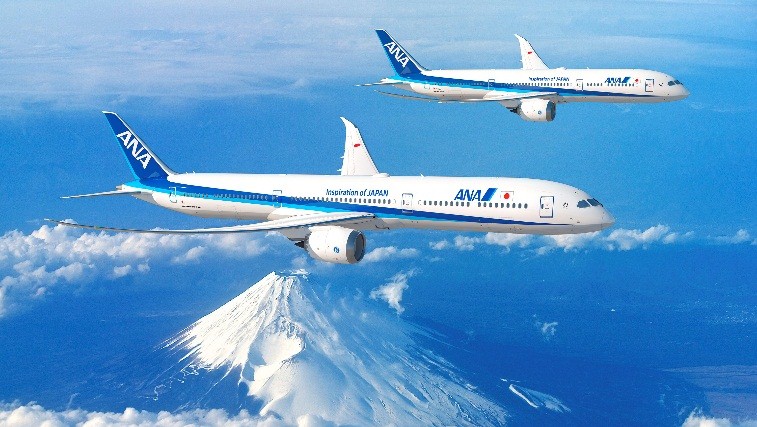Aviation
ANA HOLDINGS Commits to Adding up to 20 Boeing 787 Dreamliner Jets

– Japan’s five-star carrier plans to acquire 11 787-10 airplanes, four 787-9s jet and five options
– Deal marks ANA’s sixth Dreamliner purchase; order book to eclipse 100 airplanes once options are exercised
– ANA plans to use the largest, most efficient Dreamliner to replace certain domestic 777 models
Boeing [NYSE:BA] and ANA HOLDINGS INC. (ANA HD) announced the Japanese airline group today decided to acquire up to 20 more 787 Dreamliner airplanes. The agreement with Boeing includes 11 787-10s, one 787-9 and options for five 787-9s valued at more than $5 billion at list prices. The airline also plans to acquire three new 787-9 airplanes from Atlantis Aviation Corporation.
Once the agreements are finalized, it will be ANA’s sixth order for the ultra-efficient and passenger-pleasing Dreamliner and bring their overall 787 order book to more than 100 airplanes.
With this order, the airline will add 11 of the largest and most fuel-efficient Dreamliner models, the 787-10 to its world-class fleet. Powered by a suite of new technologies and a revolutionary design, the 787-10 set a new benchmark for fuel efficiency and operating economics when it entered service in 2018. The airplane allows operators to achieve 25 percent better fuel efficiency per seat compared to older airplanes in its class.
ANA sees the 787-10 as the perfect airplane to replace previous domestic 777 models that are slated for retirement.
ANA became the global launch customer of the 787 Dreamliner when it placed its initial order in 2004. Since then, like half of all Dreamliner operators, the Japanese carrier has placed follow-on orders. However, ANA is in a class by itself as the world’s biggest 787 operator with 71 airplanes in its fleet and 12 more to be delivered prior to the latest agreement. The new deal will bring the 11 additional 787-10 airplanes, one 787-9 and options for five more 787-9 jets.

Aviation
Boeing, Antonov to Collaborate on Defense Projects

– MOU represents Boeing’s commitment to work with Ukrainian industry
– Includes exploring opportunities for collaborating on in-country support of Unmanned Aerial Systems
A Memorandum of Understanding was signed today by Boeing and Antonov Company to investigate potential collaboration on defense-related projects.
“We’re happy to keep collaborating with the Antonov Company to help Ukraine’s economic development and expansion,” stated Ted Colbert, CEO and president of Boeing Defence, Space, & Security.
Airbus and the Antonov An-225: The Best Partnership:Click here
“This agreement demonstrates our ongoing efforts to find more opportunities to work with Ukrainian industry, which was underscored by our signing of the Ukrainian Defence Industry Compact earlier this year.”
The areas of potential collaboration identified in the agreement consist of training, logistical support and overhaul services for tactical Unmanned Aerial Systems utilized by the Ukrainian Armed Forces, which includes the ScanEagle. In addition, the companies will also explore opportunities for Antonov to provide engineering support to Boeing.
The six largest cargo aircraft ever built in the aviation industry:Click here
“A strong, innovative, and efficient defense industry is key to sustainable economic development and national security, and we are extremely excited to collaborate with Boeing,” said Ievhen Gavrylov, CEO of Antonov Company.
This agreement brings a whole new level of opportunity to implement the latest and most effective solutions – in addition to the possibility of future projects with Boeing in the aerospace and defense industry.”
-

 Travel1 week ago
Travel1 week agoAir India to Expand US Operations with Three New Routes After a Decade
-

 Travel2 weeks ago
Travel2 weeks agoWhy We Should Avoid These Stamps in a Passport
-

 Airlines1 month ago
Airlines1 month agoInvestigations Reveal Fake Chinese Titanium in Boeing and Airbus Jets
-

 Tech4 weeks ago
Tech4 weeks agoChina’s CATL Plans 1,800-Mile Electric Plane Launch by 2027
-

 Airport3 days ago
Airport3 days agoTop 10 Largest Airports in the World by Size
-

 Aerospace4 weeks ago
Aerospace4 weeks agoChina’s Fighter Jets Turn Wings into Autonomous Drones
-

 Airlines4 days ago
Airlines4 days agoAir India Rolls Out A350s for Delhi-New York JFK and Newark Routes
-

 Defence3 weeks ago
Defence3 weeks agoBoeing Enhances Chinook with New Engines and Block II Upgrades at $96 Million







